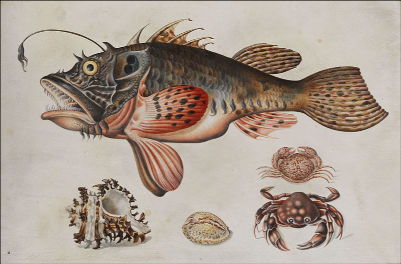More than half of the planet is covered by the deep sea and yet we know less about this extreme ecosystem than we know about the moon – only 5% of the deep sea has been explored so far. Until the mid-19th century, it was believed that the oceans below 600m are entirely uninhabited. It was only through research expeditions in the 1960s, that scientists discovered the true biodiversity of the deep sea. In fact, the deep sea is very rich in species, even if the total number of creatures decreases with increasing depth. From luminescent fish to fish with huge eyes and almost transparent organisms, a great variety of strange species can be found in the depths of the seas.

But why does life evolve in such bizarre forms? The cause lies in the extreme natural conditions of the deep sea. Two factors, in particular, make the deep sea so hostile to life: the darkness and the immense pressure. Although the rays of sunlight reach down to a depth of about 900 meters, the light energy is barely sufficient for any plant growth below 150 meters. Plants are the foundation of almost all food chains on earth. So what do creatures in the lightless depths of the oceans feed on? The majority of deep-sea organisms depend on organic material that sinks from higher layers, but only 1% of organic waste reaches the bottom. Some deep-sea animals also migrate to higher water layers at night to find food sources.
Atmospheric pressure at sea level is about one bar. For every ten meters of depth, it increases by another bar. At a depth of 10,000 meters, each square centimeter bears a weight of about one tonne. To withstand this enormous pressure, the bodies of deep-sea fish are mainly composed of water, lack cavities, and possess increased internal pressure. That’s also why they would collapse at the surface under normal atmospheric pressure. Moreover, the deep-sea water is ice-cold – beyond a depth of 1000 meters, the temperature averages 2-3 degrees.
Contrary to all myths, deep-sea creatures are on average only 25-30cm large, since the food supply is so scarce. The largest animal in the deep sea is the giant squid, architheutis, which can grow up to 20 meters in length. The squid has ten arms and lives at depths of 500-1000 meters. With a diameter of 25 cm, the eyes of the giant squid are known to be the largest of all species, which has probably evolved as an adaptation to the extreme darkness. Giant squids feed on smaller squids and fish and grow very quickly since their life expectancy is only 3-5 years. The only predator that can pose a threat to architheutis is the sperm whale which is the only mammal capable of diving for several hours up to 3000 meters deep.
However, the large majority of deep sea species live in the mud layers at the bottom of the sea. From worms to snails and mussels, more than 200,000 different species, have been found there, particularly in the first centimeters of mud. 4000 meters under the sea, more than half of the total mass of organisms are sea cucumbers. These cylinder-shaped echinoderms, which can reach up to 2 meters in size, feed on dead organic material in the sediment layers.
Source: https://www.planet-wissen.de/natur/tiere_im_wasser/tiere_der_tiefsee/index.html

